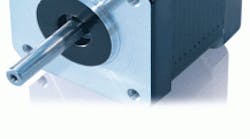Authored by: Mindy Cheng |
Those who use stepmotors know these motors are infamous for failure or stalling just when they’re needed the most. It is easy to assume the motor just went bad when this happens. However, a deeper look during troubleshooting often exposes the real reason the motor failed and a long-term solution that prevents future malfunctions.
Stepmotors, like any mechanical or electrical device, have inherent performance efficiencies and operational limitations. The trick, of course, is to choose the stepmotor that will operate most efficiently without exceeding its performance limitations.
The engineers at Lin Engineering Inc. coined the phrase “Maximize torque at desired speed” to simplify this process. The term describes the process of selecting a motor that operates at its most-efficient output with maximum available dynamic torque while maintaining operating speed. Doing so should minimize any motor stall, under performance, or other types of failure. On the surface, that sounds easy. But trial-and-error motor selection still occurs by both the equipment maker and motor manufacturer. The OEM installs their choice for the motor, but finds it lacking in acceleration, top speed, or life expectancy. They turn to the motor manufacturer who gives them another motor with those three special words, “Here, try this,” instead of determining why the first motor failed.
So how much torque is really needed for a chosen speed? In general, stepmotor users have difficulty in finding the operating speed range and the torque needed to move the associated load. Yet it’s essential to understand and calculate these two parameters when selecting a motor. Doing so makes the difference between selecting a motor that’s overdriven and fails or one that hums like a bird because it’s running at its most efficient state.
There are a few things to keep in mind during these calculations that help improve results. First, always give a specific value of rotational speed for the application in revolutions per second (rps) or revolutions per minute (rpm). You can also use pulses per second (pps) as long as the microstep resolution information, the number of pulses per step, is provided as well. Many requests for motors come in with speeds marked “slow” or “fast.” Keeping speed a numerical reference eliminates many follow-up questions later.
Second, use an easy torque calculation to determine your inertial load, and multiply that by how quickly this load is to move. In other words, torque equals inertial load times acceleration:
T = J X a
where T = torque, J = inertia, and a = acceleration. You can estimate inertia by taking half the mass of an object multiplied by the radius squared, or one of the other variations on this equation:
J = mr2 / 2
where J = inertia, m = mass, and r = radius.
With speed and torque needs determined, the next step determines the proper coils for the stepmotor to output the best performance with the minimum amount of power. Published efficiency curves help identify the closest winding that meets the needs of the application. However, the closest winding may not be the optimum choice for this application. The motor manufacturer can then adjust winding parameters, such as number of turns, wire-gage size, and so forth, to bring the motor into its best performance and efficiency range.
In a typical example, consider three different motor efficiencies plotted across a speed range. One motor performs best only at low speeds, others at high speeds. While the highspeed motor might generate enough torque to handle the application, it uses more power at lower speeds. The higher power consumption means the motor is overdriven and that shortens its life. Clearly, then, efficiency is a vital piece of the selection criteria.
Some users find it difficult to get a motor that operates at the desired speed with sufficient torque. This is one area where the term “Maximize torque at desired speed” can help. One user recently approached us after trial-and-error motor selections failed to yield a properly sized motor that would work with the current and voltage in their system. Calculations showed the operating speed of the motor was 5 rps (or 1,000 pps, full stepping). The existing motor produced around 5 oz-in. of dynamic torque. But the torque needed to move the load was closer to 10 oz-in. The practice of “Maximize torque at desired speed” let Lin engineers adapt a winding able to meet the torque demand at operating speed.
Just remember, torque issues may signal that you’ve selected the wrong motor for the job. Every motor has a predetermined set of characteristics and there is a right motor for every job. Motor selection done correctly can save months of qualifying time or can prevent shipping the product with an inadequate motor.
Related Article:
